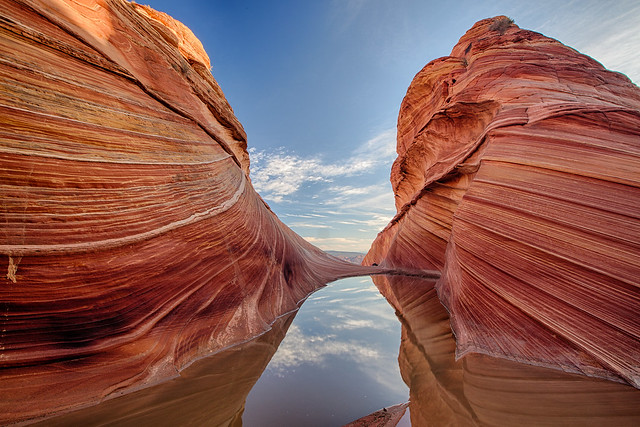 |
| Peaks, Cliffs, and Highway Vermilion Cliffs National Monument. Vermilion Cliffs, Utah. March 25, 2016. Copyright © 2017 A. F. Litt, All Rights Reserved http://www.aflitt.com/vermillioncliffsnm https://sites.google.com/view/nationalmonumentsindanger/monuments/vermillion-cliffs |
National Monuments in Danger
https://sites.google.com/view/nationalmonumentsindanger/homeAs I wrote some time ago, I "missed" this monument on my travels last year. We drove a few miles from our campsite at Lee's Ferry in the Glen Canyon National Recreation Area to "count coup" on this monument and to take a couple pictures of the cliffs, but then rolled on to the Grand Canyon.
In hindsight, our time would have been more enjoyable spending some time here, rather than taking a couple quick shots of the canyon while dealing with the crazy crowds for a few hours at the south rim.
Unfortunately, it was March and all the visitor centers were closed before we made it to them, and we didn't realize how much there was to do in the area until it was way too late.
The Wave is by far the most famous landmark here, and difficult to gain permits to visit. But there are other similar features and many slot canyons, I understand, worth checking out, some requiring a desert backpacking adventure, but others more easily accessible (at least with a proper vehicle). "Though located only a few miles from Lake Powell and its legions of pleasure craft, the 300,000 acres encompassed by the monument are no place for the fainthearted or unprepared," explains a 2012 article in National Geographic, where I first heard of this monument. "'Exit the car, enter the food chain,' quipped one official with the Bureau of Land Management, which administers the monument."
National Geographic: Vermilion Cliffs National Monument (February 2002)
Directly in front of you rises a chaos of rock vaulting nearly 3,000 feet—the Vermilion Cliffs. The cliffs can hardly be said to have a face. They have innumerable faces, fractured and serrated, crosshatched and slumped. You can feel the inertia in their colossal vertical fissures. Along the lower wedding cake tiers, rubble piles resemble the sand in the bottom of an hourglass.
And now the question: How long would you have to wait until the Vermilion Cliffs calved a boulder the size of a school bus, say? The answer: It could happen the day you sit down. But it's likelier that your descendants' descendants would still be sitting in that chair, many hundreds of generations later, waiting for the cliffs to crumble a little more. The rock is ancient, and so are the traces of erosion.
http://ngm.nationalgeographic.com/2012/02/vermilion-cliffs/klinkenborg-text
While the cliffs are spectacular, in many ways this monument should be called the Paria Plateau National Monument. The cliffs them selves have been protected by Congress as a wilderness area since 1984, but the plateau above the cliffs is what is at risk in this process, and the Paria Plateau, by all accounts, is an amazing place.

From the National Geographic article:
The Paria Plateau and its hem of cliffs were named a national monument by presidential proclamation in the year 2000, primarily in recognition of the exquisite archive of erosional forms—timescapes, windscapes, gravityscapes, and waterscapes but above all, sandscapes. There is the sand of the present day: the grit in your teeth, the slip-sink footing, the slithering tire-bog along the tracks in the Sand Hills mid-plateau. That sand (ancient enough, grain by grain) is derived from prehistoric sand—the Navajo sandstone that forms the plateau and cliffs. This sandstone, in turn, is the remains of a vast erg, a windblown sea of dunes that for millions of years covered most of what is now the Colorado Plateau. The geology is hard to imagine. It becomes even harder if you're lucky enough to come upon the Wave, hidden away in the northwest corner of the monument in a place called Coyote Buttes.
The Wave is a tumult of striped, fossilized dunes that look like petrified surf, forever rising and curving, towering just short of breaking. What's been left behind by long ages of erosion—rogue waves of smooth, banded sandstone in a bowl of light—is a record of chemical reactions taking place as the sandstone developed, with patterns of bleaching and the depositing of iron oxide and other minerals. In its sinuousness, the Wave forms a wind siphon, its geometry accelerating the wind the way a high, curving track accelerates a skateboarder.
...
To safeguard this extraordinary formation, the BLM admits only 20 people a day to the Wave, so you're left nearly alone in a wilderness containing a geological "Mona Lisa." This isn't the South Rim of the Grand Canyon, a scenic view shared with thousands. Here is the intimacy of the senses: the abrasion of stone, the scent of rain on rock, a kaleidoscopic light that can leave you bewildered by the minute speck of time you occupy in the presence of so much frozen time.
National Geographic: Richard Barnes' Photo Gallery of Vermilion Cliffs National Monument:
http://ngm.nationalgeographic.com/2012/02/vermilion-cliffs/barnes-photography
BLM: Vermilion Cliffs National Monument Map (as of June 2017) - PDF
To comment on the monument review process (due July 10, 2017):
To comment on the monument review process (due July 10, 2017):
Links
27 Monuments:
Website
https://www.27monuments.org
Facebook
https://www.facebook.com/27Monuments
Instagram
https://www.instagram.com/brentdangerrose
https://www.instagram.com/explore/tags/27monuments
Rubble: Vermilion Cliffs
BLM:
Vermilion Cliffs National Monument Website
Vermilion Cliffs National Monument Map
flikr
https://www.flickr.com/photos/mypubliclands/albums/72157634871482502
Wikipedia:
Vermilion Cliffs National Monument
https://en.wikipedia.org/wiki/Vermilion_Cliffs_National_Monument
Vermilion Cliffs National Monument
https://en.wikipedia.org/wiki/Vermilion_Cliffs_National_Monument

No comments:
Post a Comment